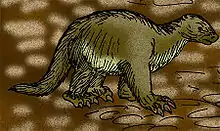Promegatherium
Promegatherium ("before Megatherium") is a genus of prehistoric xenarthrans that lived in Argentina, during the Late Miocene. This genus is regarded as closely related to the later, and more famous genus, Megatherium, hence the reference in the name. The first specimens of Promegatherium were originally described by the biologist Florentino Ameghino in 1887. Its known species are Promegatherium cabreri, P. nanum, P. parvulum, P. remulsum, and P. smaltatus. P. nanum was originally placed in the genus "Eomegatherium" before it was grouped together in Promegatherium.
| Promegatherium | |
|---|---|
 | |
| Promegatherium nanum and Nesodon | |
| Scientific classification | |
| Kingdom: | |
| Phylum: | |
| Class: | |
| Order: | |
| Family: | |
| Subfamily: | †Megatheriinae |
| Tribe: | †Megatheriini |
| Subtribe: | †Megatheriina |
| Genus: | †Promegatherium Ameghino, 1887 |
| Species | |
|
†P. cabreri | |
Fossils of Promegatherium have been found in the Ituzaingó Formation in Argentina.[1]
References
- Promegatherium at Fossilworks.org
Further reading
- Family tree of Megatheriidae
- M. C. McKenna & S. K. Bell (eds.) (1997): Classification of mammals, above the species level. New York: Columbia University Press.
This article is issued from Wikipedia. The text is licensed under Creative Commons - Attribution - Sharealike. Additional terms may apply for the media files.

